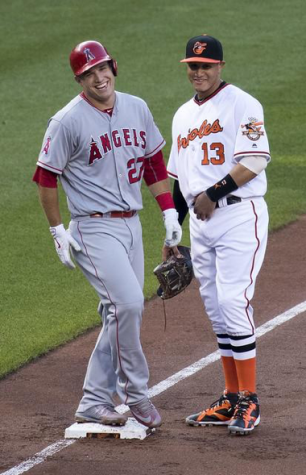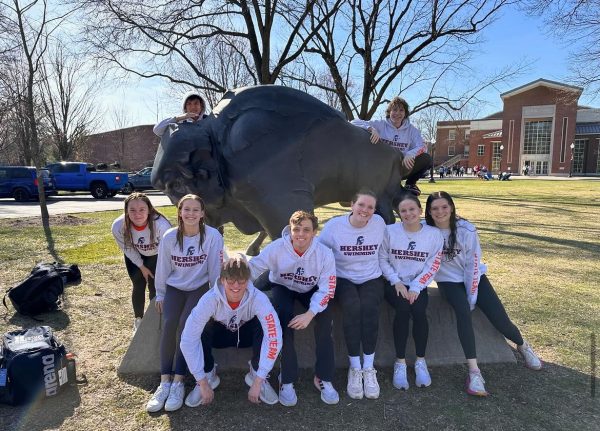MLB Free Agent Signings are likely Cause of Spike in Extensions
May 3, 2019

Extension-mania has begun.
Over the past two months, several professional baseball players and their teams have opted to extend their current contracts rather than face free agency. The cause of this hysteria is likely an effect of the two free agent bidding wars that took place this off-season.
As the MLB off-season wound down in late February, eyes were still on the two top free agents awaiting a team: Manny Machado and Bryce Harper. Both players had been receiving offers since October. However, they were still waiting for the right team contract.
Machado finally caved on February 21, as he was announced to be the newest member of the San Diego Padres. Machado’s contract was a 10-year deal worth $300 million, making him the highest paid. This made Machado’s contract the largest for a free agent in baseball history, for about two weeks.
On February 28, Harper agreed to a deal with the Philadelphia Phillies worth $330 million over 13 years. In addition, Harper has a full no-trade clause, and the club has no opt-outs. Essentially, Bryce Harper is a Phillie until he says otherwise.
While this contract is extremely player-friendly, it’s even more so after looking at Harper’s career. Entering 2019, Bryce Harper’s career batting average was .278 and he’s missed an average of 30 games a year. While these numbers have gotten him six All-Star appearances, they probably aren’t deserving of a $330 million contract.
This doesn’t mean Harper isn’t a great player. He’s fantastic. Bryce Harper, the first overall pick by the Nationals in 2010, has as much baseball talent as anyone playing today. He just has trouble showing it from time to time. Harper’s 2015 and 2017 season exhibit this talent. In both seasons, Harper’s OPS is above 1.000 and his batting average is well above .300.
However, in the five other seasons of Harper’s career, he’s never hit above .275 and his slugging percentage has never been above .500. Taking his whole career into account, Harper is an above average hitter for getting on-base, pitchers have no problem giving him a free pass, and when he does make contact, he hits the ball a mile.
So the Phillies took a risk with this contract, and it’s a risk that could easily pay off. However, historically, these contracts never do. Long-term deals, especially high-paying ones, usually become extremely player-friendly by the end. Since the trend of these contracts is very recent, most of these contracts are still active and cannot be judged in full. The only one that can is the contract that Manny Machado’s overtook as the largest in history: that of Alex Rodriguez.
Rodriguez signed a 10-year $275 million contract with the Yankees after the 2007 season. At that point, Rodriguez had won three of the last five Most Valuable Player (MVP) awards, was one of the few players in history to have 40 steals and 40 home runs in one season, and had just hit his 500th home run before the age of 32. While long-term deals are always risky, it was undeniable that the Yankees were getting one of the best players baseball had ever seen.
Suffice it to say, the contract didn’t exactly work out. In short, Rodriguez performed well his first few years with his new contract; however, Rodriguez did admit to using performance enhancing drugs before coming to the Yankees, forever tainting his legacy. In 2013, with Rodriguez’s production significantly below what it once was, he had failed a drug test and was suspended for steroid use. All in all, Rodriguez played seven and a half years during his ten year contract, as he was suspended for one and half of those ten and the Yankees forced him to become a “special advisor” during the 2017 season while still earning his planned salary.
While Rodriguez’s case may be different than most, he isn’t the only one to have their contract become overly player-friendly:
Albert Pujols signed a 10-year deal with the Angels after the 2011 season, and his OPS with his new team is over 250 points lower than it was.
Robinson Cano signed an identical deal with the Mariners after 2013, and he also was suspended for steroid use and he was eventually traded to the Mets.
Chris Davis was inked to a seven-year $161 million contract entering the 2016 season, since then, he’s hit below the Mendoza line and his total offensive production has been well below league average.
Clearly long-term, well-paying deals can become overly player-friendly very quickly, and the 2019 off-season demonstrated how much weight players hold when determining these deals.
This takes us to March 2019, when teams began signing every star player they could to a long-term extension. What an extension essentially does is add more years onto a player’s existing contract in order to delay the player from becoming a free agent. This is usually done for a player who is about to enter or has just entered the prime of their career. Why do players agree to this? Simple: it almost always comes with a large pay increase.
Signing an extension can often work out for both parties. The team is locking up a star player long-term and paying less than they would on the open market. During free agency, teams can get locked in bidding wars that result in players getting paid way more than they are statistically valued.
On the players’ side, they’re still getting more money than they’ve ever seen. To a Rookie of the Year making $500,000, an extension for $10 million a year is incredible, even if other stars are making double that. In addition, they won’t have to worry about a future slump hurting their free agency chances.
So how exactly has this taken place recently?
Immediately after Harper’s signing, rumors began circulating that Mike Trout, the best player in baseball, would soon join Harper in Philadelphia as a free agent in the coming years. Knowing that the price would be steep in a bidding war, the Angels went ahead and extended Trout for 12 years and $426.5 million. This became the largest contract in professional sports history.

Trout’s signing then sparked several other teams to sign their star players in order to avoid free agency. Within a week, six All-Stars had signed long-term extensions with their teams ranging from $50 million to $145 million in value. Among these players are both of last year’s Cy Young award winners Blake Snell and Jacob Degro, and two recent World Series Champions Justin Verlander and Chris Sale.
With so many teams signing their all-stars to big contracts, attention has been turned to the teams with rising stars who haven’t signed an extension, specifically the Yankees and Red Sox. The Yankees’ Aaron Judge and Red Sox’s Mookie Betts are two of the top outfielders in baseball today. Betts is the reigning American League MVP and Judge is the only rookie to ever hit 50 home runs in one season.
Both of these all-stars have free agency or arbitration in their future, and both Boston and New York want to keep their stars to remain as championship-contending teams. However, more than any other player, extending Judge and Betts won’t be cheap.
Boston and New York are two very big market teams. The Yankees are currently valued by Forbes at $4.6 billion, and Boston has won four World Series in the last 15 years. Knowing this, Judge and Betts will likely ask for extensions in the Mike Trout range. In fact, coming off a down year in 2017, Betts turned down an eight-year $200 million extension from Boston.
With all of these all-stars signing long term deals, eyes will be on upcoming free agents like Anthony Rendon and Gerrit Cole to raise their value before they have to make a long term decision themselves.


